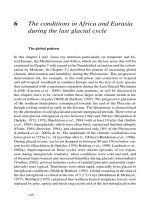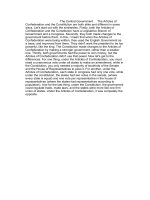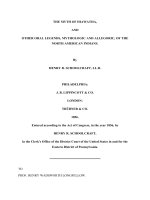comparing two documentaries one day in september and nanook of the north
Bạn đang xem bản rút gọn của tài liệu. Xem và tải ngay bản đầy đủ của tài liệu tại đây (32.53 KB, 2 trang )
These documentaries were produced in different decades, firstly One day in September was
released on the 4th September 2000, and this was a documentary on the tragic events of the
Munich Olympics.
The second documentary I watched was Nanook of the north, a story of an Inuit and his family's
life. This documentary is said to be the first feature length documentary ever, it was released in the
USA in 1922. The documentary looks at real life situations the family come up against living in
North Pole; it is a story of love, life and survival.
The Olympic Games in 1972 were in Munich, at these games the tragic events that produced the
one day in September documentary. The film is about a group of Palestinian's who kidnapped 12
of the Israeli athletes at the Olympics. The documentary is produced through archive material and
interviews. The documentary on Nanook of the North is the complete opposite because all the
images were put together at the same time and were produced in 1922. If a past event
documentary was produced today we would not be able to attract the audience without archive
material to back up the evidence and points.
Nanook of the north is in black and white due to the time it was produced, but colour was not
produced until Disney's first film of Snow white made almost a decade after. The one day in
September archive footage is in colour but not perfect condition because the event happened in the
70's and the footage was used 30 years later, where today technology has improved.
Nanook of the north is one continuous story with short pauses for information to flash up so we
understand what is happening. There was no sound in this documentary, although sound make
documentaries more interesting and dramatic/emotional, Nanook of the north still achieved this by
emotive shots and meanings through the flash ups of information.
Interviews are used in One day in September these interviews bring the story together and give the
audience a chance to see his feelings and thoughts that were not in the archive material. Although
there is a problem with this, because interviews are produced later than the archive material which
was taken at the time, with interviews information could have been forgotten or the view could be
bias or they may just not want to add a bit in. A positive aspect to the interview is that we don't see
the interviewer this makes the person on camera seem as through they are talking to the person
watching the film, so makes the audience feel more involved. This is harder in Nanook because no
sound or interviews appear as this was the first documentary the concept was simple, There was
Footage and information.
In one day in September more complex factors are used to attract the audience, it uses interviews,
archive material, sound, sound effects, imagery, a narrator and eye-witness accounts.
In both documentaries there is a good range of visual effects, these included emotional
chronological images, so in One day in September they would have been each hour of the event
and in Nanook of the north it would have been each day, although we are unaware if the shots
were daily because they are all edited to produce a length of 87 minutes.
In both documentaries they used the images that they know will attract the attention and keep the
audience watching, for example in Nanook of the north there could have been days were they did
nothing and this would be edited because the audience would not be interested.
The visual images are usually the most dramatic or tragic ones, this is evident in both
documentaries. In one day in September, the used of dead bodies and people faces at the event
shows how intense and tragic the situation was, and in this documentary the narrator connects the
image with what he says for example as the camera panned across the crowd the narrator said
"There was fear among their faces." In Nanook of the north the same idea was used but without
sound. For example a key event in the documentary is when they are running low on food and
hunting for survival. Information comes up in black and white simple font to tell us this; it then
shows a close up of them killing a walrus at the sea edge and eating it raw due to starvation.
Another problem with Nanook is that we don't get to learn much background on the family
because in comparison to One day in September which uses lots. For example In the documentary
we meet Jamal al gashey a terrorist from the event and we get to no what he was like when he was
young, what he's like now and what he was like then.
In comparison One day in September is a better informing piece than Nanook because it uses
more factors to keep the audience interested, although both pieces are informing. One day in
September is more developed due to time it was produced. The two show a big difference in the
development of documentaries but I think Nanook was a very influential film to start of the
documentary genre.









